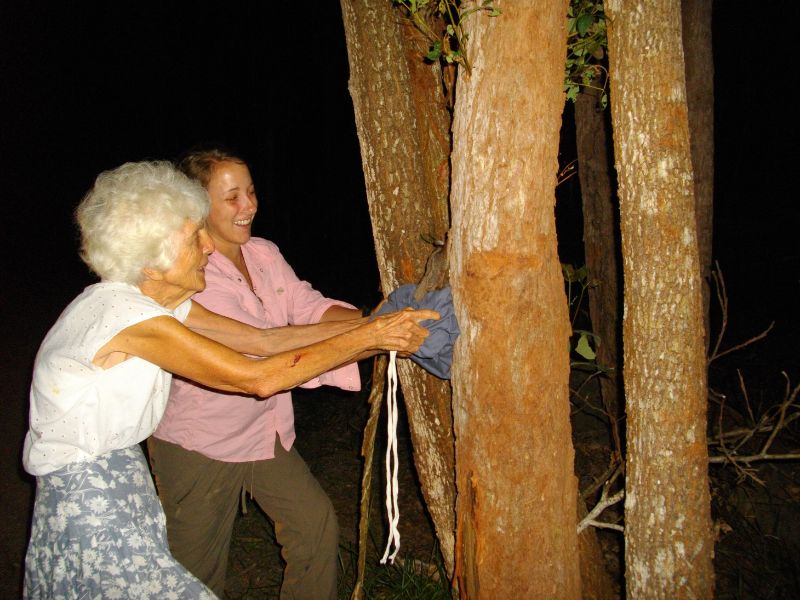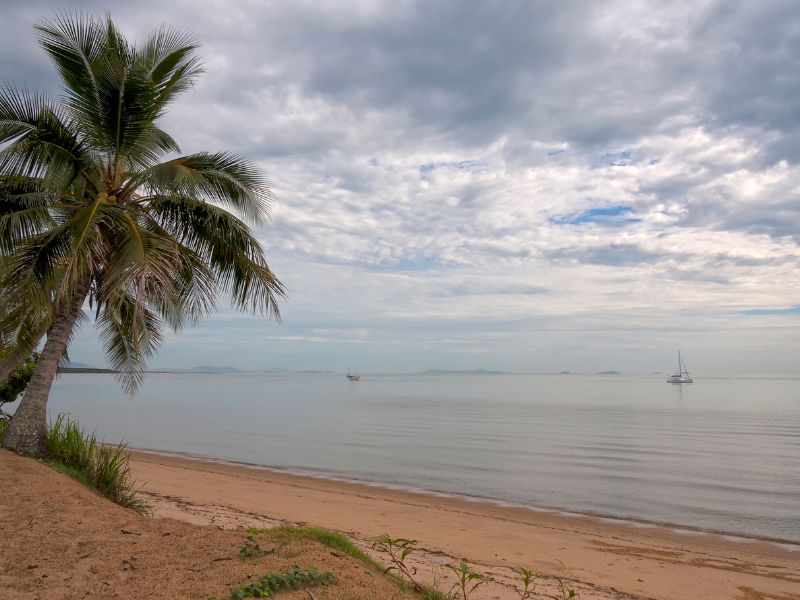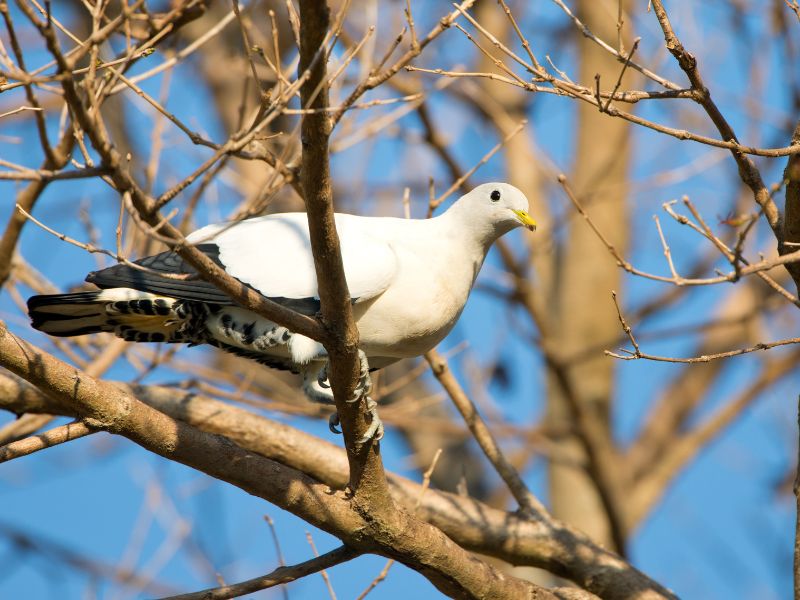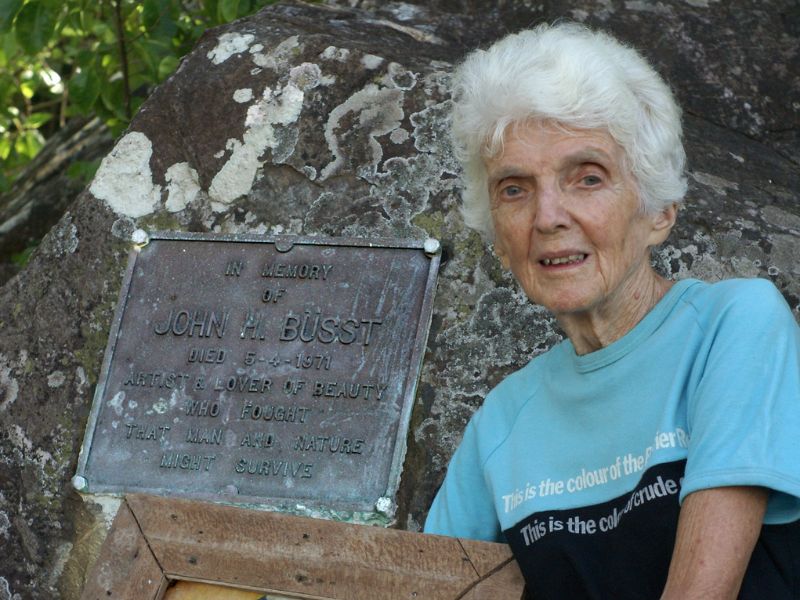The Thorsborne Trust
© Lorraine Harris
About the Thorsborne Trust
In 1991, the Thorsborne Trust was launched to recognise a unique champion of the environment, the late Arthur Thorsborne, and to commemorate his achievements.
The Trust aims:
- to support activities for a better understanding of, and conservation of, Australian native species, in particular, the Torres Strait pigeon (now the pied imperial pigeon) and the cassowary
- to support activities for a better understanding of, and conservation of, the natural environments in particular of Hinchinbrook Island and environs and the wallum country of South East Queensland
- to support endeavours for the protection and restoration of significant natural habitats and ecosystems
- to foster environmental awareness, particularly in the education of young people
- to raise and disburse funds for all of the above goals.
 © Suzie Smith
© Suzie Smith
The late Margaret Thorsborne releasing a mahogany glider after Cyclone Yasi.
The Trust was launched by the then director of Wildlife Queensland, Adrian Jeffreys, at the Society’s northern branches get-together at Daradgee, near Innisfail, in June 1991. The following December, the Trust was publicly launched in Cardwell by the then Queensland Environment Minister, the Hon. Pat Comben.
Speaking at this event, Paul Sutton, President of the Hinchinbrook branch, likened the work of Margaret and Arthur Thorsborne to two sets of footprints travelling along a beach, sometimes joined by others: ‘In time the footprints will change as each of us leaves the procession, but the journey must go on. These Trust objectives contain the photographs of the past as their immediate focus, as well as the flexibility to grow and change with the needs of the future.’
Trust activities
Guided by past Wildlife Queensland patron, the late Margaret Thorsborne, the Trust has over the past 20 years, initiated and actively supported, financed and promoted a range of projects and activities, in keeping with its aims. These include the below activities.
Conservation, research and publications
- Financial support for scientific research into native species and habitat in the region, including:
- $6,000 to Dr Stephen Jackson enabling him to complete his doctoral research on the mahogany glider (Petaurus gracilis)
- $1,000 to support Joan Bentrupperbaumer’s research into Cape York cassowaries
- $3,000 to Birds Australia NQ and CSIRO for post-Yasi cassowary research
- $1,000 to Museum Victoria/JCU for research into mahogany glider DNA.
- Generous financial support for the publication of the 2-volume work Butterflies of Australia: their identification, biology and distribution by Dr Michael Braby.
- Joint funding (with the World Wide Fund for Nature) of the publication of Dr Stephen Skull’s book Plants of the Melaleuca Woodlands, with illustrations by Lucy Smith.
Habitat protection and restoration
- The creation and maintenance of the Arthur Thorsborne Arboretum on an area of degraded land at the entrance to the Edmund Kennedy National Park. Native species of importance to the pied imperial-pigeon and the cassowary are featured. The arboretum flourished under Margaret Thorsborne’s personal care, with assistance from friends, QPWS and other organisations. In particular, the long-term commitment of Outward Bound Australia was immensely significant for the success of the Arboretum.
- Funding for projects to encourage and achieve rehabilitation of local environments.
- A number of other tree plantings and revegetation projects in the Cardwell region, including a stand of 40 paperbarks (Melaleuca leucadendra) at the southern approach to the town.
- Timely intervention in August 1997 to protect an area of unallocated state land extending for more than a kilometre along the mainland coast of the Hinchinbrook Channel. Identified as critical mahogany glider habitat, it contains important and vulnerable vegetation communities, and a nationally important wetland site and was listed as a Regional Ecosystem of Concern by the then Queensland Department of Environment. The Trust’s application to lease this land for conservation purposes helped to forestall its loss to private development interests that would have destroyed its conservation values. The land now forms part of the Girramay National Park.
- Gift of $1000 towards care of the Pine Ridge Reserve, protecting an area of wallum country on the Gold Coast. The creation of this reserve, in the 1960s, was one of the Thorsbornes’ early conservation successes.
Environmental education
- Creation of the pied imperial-pigeon display, in conjunction with the then Qld Dept. of Environment and Heritage, for the Cardwell Information Centre.
- Funding the publication of three volumes of environmental poetry (1996–2000) resulting from a North Queensland Conservation Council project designed to encourage community awareness of the environment, especially among young people.
- Regular and generous donations of books on natural history or conservation topics to school and public libraries in the region.
- Ongoing donation of annual subscriptions to Wildlife Australia to four public libraries in the region.
- Submission of articles to community newsletters and to Wildlife Australia.
- Involvement of schools and other groups in revegetation activities at the Arboretum, thus providing practical experience for the mostly youthful participants while enhancing their environmental awareness. As already mentioned, Outward Bound Australia became closely involved in this project over a period of 14 years.
- Small gifts of money and materials to local state primary schools to support environmental projects.
Wildlife conservation and care
- Continued involvement in, and support for, the annual monitoring of the pied imperial-pigeon breeding colony on North Brook Island.
- Funding for local projects assisting the care and protection of a variety of species including flying-foxes (educational brochures), greater gliders (safe fencing materials) and cassowaries (cassowary alert road signs).
- Provision of funds to carers in Ingham (Virginia McGrath) and on Townsville’s Magnetic Island (Tania Schuett) for the care and treatment of injured or orphaned wildlife.
- Provision of funds for fencing materials at Currawinya National Park to aid bilby conservation.
Donations to the Thorsborne Trust can be made via Wildlife Queensland head office or online via our donation page.
Expanded information on Trust activities
Arthur Thorsborne Arboretum
The creation of this Arboretum, situated north of Cardwell on an area of degraded land at the entrance to Edmund Kennedy National Park, began in August 1992 with the support and cooperation of the then Queensland Department of Environment and Heritage.
Its primary aim was to become a resource for both pied imperial-pigeons and cassowaries.
To this end, food trees important to both species were selected for planting. More broadly, it was intended that the arboretum would ‘show the beauty and usefulness of trees which support local wildlife and to encourage widespread plantings throughout the district’ (TT newsletter 1993).
In the first year, 300 trees were planted by local residents, QDEH staff, friends and visitors of the Thorsbornes and Outward Bound participants. Taps and hoses were purchased by the Trust to aid watering in drought times.
Read more
Planting continued over the following years alongside the constant work of weeding, watering and mulching to ensure that the trees survived and flourished. While a major part of this work was carried out by Margaret herself, she had many willing helpers. The annual visits of Outward Bound groups, over a 14-year period from 1992 and 2005, were hugely important. The happy tradition of spending a day working in the arboretum at the completion of their course was enjoyed equally by Margaret and the course participants, many of whom left comments in Margaret’s visitor’s book, expressing profound gratitude and appreciation. Another group, which took time out from study for some hands-on conservation work, came from one of the Australian study programs of the US-based Arcadia University, while other friends and visitors have also helped out when passing through.
As the Arboretum matured, proof of its worth was the sight of a cassowary feeding on fallen fruit and pied-imperial pigeons, and other frugivorous birds, in the branches of its trees. After surviving many years of drought, the Arboretum was in peak condition before being struck by two severe cyclones. Cyclone Larry did considerable damage in 2006, but a positive aspect was found in its restoration. With much of the region’s banana crops destroyed, some of those who had lost their jobs in the industry found at least temporary employment helping to repair the Arboretum.
Despite this set-back, the prolonged wet seasons of 2009 and 2010 meant that the Arboretum was looking better than ever before being struck by the full force of severe category 5 Cyclone Yasi in February 2011. Following the storm, the Arboretum, like the surrounding forest, was a scene of complete devastation, with many trees completely felled and those still upright resembling broken matchsticks. In the space of a few hours, the terrible force of the winds had rendered it completely unrecognisable from what had stood there just a few hours before.
Recovery from such a disaster must inevitably be long-term, but repair and restoration began swiftly with the invaluable efforts of Neil Parker, from DERM, who travelled from Cairns on a regular basis to work in the Arboretum, with Margaret’s advice and assistance.
 © Canva NFP
© Canva NFP
Hinchinbrook Channel at Cardwell.
Protection of land on the western shore of Hinchinbrook Channel
In August 1997, the Trust became aware that Cardwell Properties Pty Ltd (the company responsible for the Port Hinchinbrook development) had made an application to lease an area of vacant crown land (aka unallocated state land) on the western shore of the Hinchinbrook Channel.
This land was situated south of Stoney Creek and the Port Hinchinbrook development, where Margaret had already faced the bulldozers and was known to have significant conservation values. These related particularly to the endangered mahogany glider, the rare and threatened palm Livistonia drudei, and several important vegetation communities classified as ‘at risk’, ‘vulnerable’ or ‘of concern’.
The application by Cardwell Properties was for Lots 33 and 24 on VCL38644.
In order to forestall the loss of this public land to private interests, the Trust immediately took the initiative of lodging its own application to lease VCL38644, as well as an adjacent and equally important area (VCL38632) which extended to the existing National Park boundary, and 2 small islands in the nearby Channel (VCL 38943, lots 5 and 6).
The Trust stated that its lease application was for conservation purposes only and made it clear that the application would be withdrawn if it received assurance that the State Government would manage the land for conservation. Should this be the case the Trust offered to assist with such management if required.
In the event, the Trust’s application was unsuccessful, but nonetheless the action was believed to have been an important factor in helping to keep this land in public hands and protect its conservation values. All of the above-named areas were subsequently gazetted to form part of what later became the Girramay National Park
Pied imperial pigeon monitoring project
The annual monitoring survey of the pied imperial pigeon breeding colony on North Brook Island was begun by Margaret and Arthur Thorsborne in 1965 and was coupled with their concerted campaigns to stop the indiscriminate slaughter of the birds by local shooters and to protect the birds’ food source in the coastal woodlands of the mainland.
Each year, the Thorsbornes, sometimes accompanied by friends, continued to conduct counts on the island, carefully recording and reporting their totals.
In the 1980s, the Queensland Parks and Wildlife Service assumed responsibility for the annual surveys, for many years under the expert guidance and passionate commitment of QPWS officer Dave Green. Currently, three counts are conducted between October and December each year.
The project is one of the longest continuous wildlife monitoring surveys in Australia, and the records show an amazing success story with numbers rising from a low point of 1600 birds (following a large-scale shoot in 1968) to a pre-Yasi total of between 35,000 and 47,000 birds.
 © Canva NFP
© Canva NFP
Pied imperial pigeon (Ducula bicolor)
The full effects of Cyclone Yasi, which devastated the birds’ nesting habitat and their mainland food source, are still being investigated. Through the active participation of one of the trustees, John Winter, the Trust continues to support the counts and promote their importance. Seed collection and revegetation activities of the Trust further support the survival of these beautiful birds and the health of their colony.
John Winter is currently working to ensure that the counts are established on a permanent and sound scientific basis so that they will continue to provide invaluable data on these birds long into the future.
Funding and publications
- Adams, Jeannie. Mangroves alive! (Cardwell library, Tully library)
- Braby, Michael. Butterflies of Australia: their identification, biology and distribution, Vols 1–2 (Cardwell, Tully, Ingham, Mission Beach libraries; Ingham SHS, Tully SHS)
- Braby, Michael, Complete field guide to the butterflies of Australia (Cardwell, Tully, Ingham, Mission Beach libraries)
- Finney, C.M. To sail beyond the sunset: natural history in Australia 1699–1829 (Cardwell library, Ingham SHS, Innisfail SHS, Townsville Correctional Centre library, Gold Coast WPSQ student library)
- Frith, Dawn & Frith, Cliff. Cape York Peninsula: a natural history (Cardwell library)
- McArthur, Kathleen. Looking at Australian wildflowers (Cardwell library)
- McKay, Judith. Brilliant careers: women collectors and illustrators in Queensland (Cardwell library)
- Scarth-Johnson, Vera. National treasures: flowering plants of Cooktown and northern Australia (Cardwell library, Ingham SHS, Tully SHS)
- Skull, Stephen. Plants of the Melaleuca woodlands (Cardwell library, with a further 30 copies to schools and libraries)
- Strahan, Ronald (ed.) Complete book of Australian mammals (Cardwell library)
- Suzuki, David. Good news for a change (Cardwell, Tully, Ingham, Mission Beach libraries)
- Wieneke, Jo. Birds of Townsville (Cardwell library)
- Wieneke, Jo. Where to find birds in North Queensland (Cardwell library)
- Williams, Keith. Native Plants of Queensland Vols 1–3 (Cardwell library)
- Wildlife Australia – annual subscriptions donated to Cardwell, Tully, Ingham and Mission Beach libraries.
Articles for newsletters and magazines
- Wildlife Australia, vol. 31, no. 2, Winter 1994. ‘Jewels in paper’ by Michael Braby.
- Wildlife Australia, vol. 31, no. 2, Winter 1994. ‘Introducing Queensland’s wet tropical lowlands’ by Peter Stanton.
- Wildlife Australia, vol. 31 no. 3, Spring 1994. ‘Afternoon flight: conserving Torresian imperial-Pigeons by John Winter.
- Newsletter, Cardwell Neighbourhood Watch (1990s). Plants of the Cardwell Seashore, regular weekly articles by Margaret Thorsborne.
Details of funding for publications
- $1,000 for production of Lucy Smith’s illustrations in Stephen Skull’s Plants of the Melaleuca woodlands, published by James Cook University.
- $1,700 to cover the cost of scientific line drawings produced by students at the University of Newcastle, in Michael Braby’s Butterflies of Australia, published CSIRO.
- $1,836 for the publication of 3 anthologies of environmental poetry Caring for the Environment; Come gently; And look beyond, edited by Alan Webb, published by North Queensland Conservation Council.
Details of funding for research
- $6,000 (1995-1998) to Stephen Jackson for mahogany glider doctoral research.
- $1,000 (1995) to Joan Bentrupperbaumer for research on Cape York cassowaries.
- $500 (2000) for research into pollinators of the rare blue banksia, by JCU Honours student James Robertson.
- $200 (2000) for research into the vulnerable beach stone-curlew by JCU student, Jodie Collins, aimed at assisting the bird’s conservation by developing a public awareness strategy.
- $2,000 (2007) to support QPWS overseas volunteers Yumiko Asari and Morgane Heriot, for mahogany glider work.
- $1,000 (2008) to Paul Ferraro, Museum Victoria and James Cook University, for mahogany glider DNA research.
- $500 (2008) to Dr Lyndon deVantier, for travel expenses in connection with rapid field assessment of the North Brook island corals.
- $1,600 (2009) to Stephen Jackson for travel and other expenses connected with mahogany glider research.
- $3,000 (2011) to Birds Australia NQ, to support CSIRO’s DNA analysis of cassowaries following cyclone Yasi.
Details of funding for wildlife protection and care
- $800 to wildlife carers Virginia McGrath (Ingham) and Tanya Schuett (Magnetic Island).
- $150 for cassowary alert road signs.
- $500 WPSQ Bilby fund, for purchase of fence materials to exclude feral predators from the bilby re-introduction site at Currawinya National Park.
- $500 (2009) to Rupert Russell in support of a project to protect greater gliders from barbed wire fencing, boundary of Blackbraes NP.
- $400 (2010) to Tolga Bat Rescue & Research Inc., towards Wildlife-friendly fencing brochures.
Details of funding for habitat restoration
- $1,000 (1995) – pledged to Gold Coast City Council for the care of the Pine Ridge Reserve
- $380 (2002) – for the cost of videos Habitat in danger and Rehabilitation of our wetlands produced by Ross Digman, distributed to Government departments and agencies, conservation groups and other interested parties.
- $2,000 (2004) – to Riversdale Murray Valley Water Management Board towards the creation of lagoon for water quality improvement and aquatic wildlife habitat.
Details of funding for school projects
- Murray Upper State School: presentation of $50, a selection of butterfly host plants and informative leaflets, in support of the school’s butterfly garden project.
- Toobanna State School: presentation of $50 to support school’s submission to Main Roads for tree planting and beautification of roadside and to keep a photographic record of the project.
- Kennedy State School: presentation of two disposable cameras to photograph plants found in the Edmund Kennedy NP, as part of the school’s swamp display project.
- Kennedy State School: donation of $100 towards the cost of an environmental outing.
 © Suzie Smith
© Suzie Smith
The late Margaret Thorsborne AO.
Margaret Thorsborne AO
In recognition of her work, Margaret Thorsborne was made an Officer of the Order of Australia in 2011.
Trustees
- Margaret Thorsborne AO
- John Muller (WPSQ)
- Peter Stanton (formerly QPWS)
- Paul Sutton (WPSQ)
- John Thorsborne
- John Winter
